As we age, our gardening needs and preferences can change, but this doesn’t mean we need to hang up our gardening gloves. In fact, gardening can be an enriching and therapeutic activity for seniors, offering both physical exercise and a sense of accomplishment. However, it’s essential to choose the right plants – ones that are low-maintenance, easy to handle, and provide beautiful rewards. In this article, we will explore some of the best garden plants that are senior-friendly. So, whether you’re a senior gardener or are planning a garden for an older loved one, these plants will ensure the gardening experience remains enjoyable, safe, and fulfilling, regardless of age.
1. Marigold (Tagetes spp.)
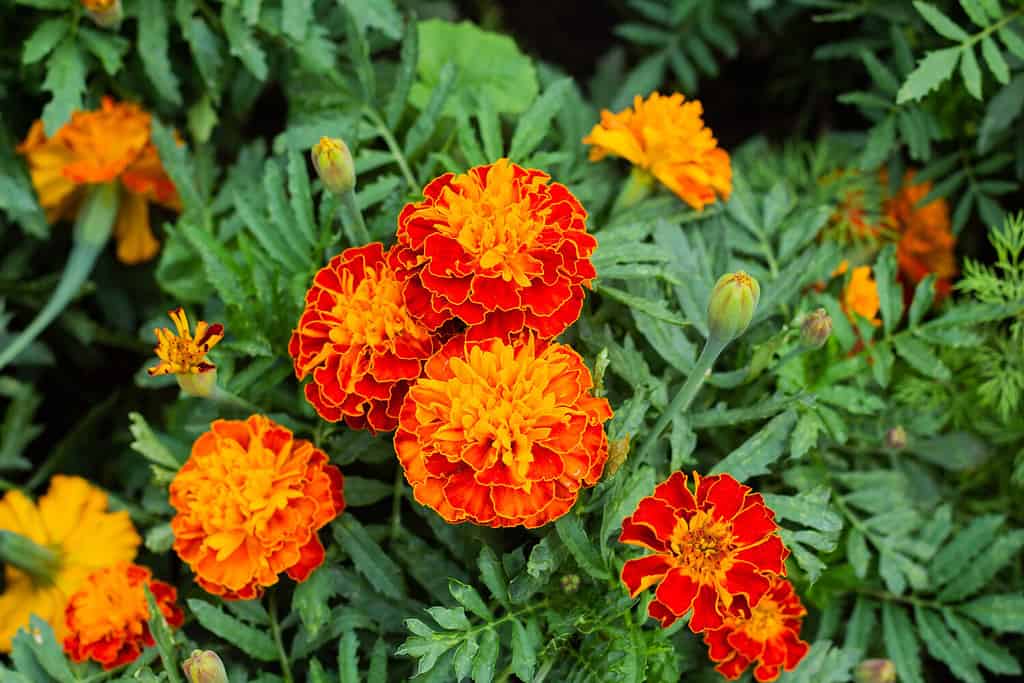
One of the easiest to care for garden plants for seniors is marigolds.
©FunFamilyRu/Shutterstock.com
Marigolds boast delightful, fluffy, daisy-like blooms that flaunt different shades, including yellow, golden, orange, red, and deep mahogany. There are also unique varieties exhibiting striped, two-tone, or cream-colored flowers.
The ideal time to plant your marigolds is in spring, once the final frost has passed. If you prefer to begin with seeds indoors, initiate this process around two months before the last anticipated frost.
These flowers thrive in ample sunlight and soil that drains effectively. Expect to see them blossom from late spring through fall. Marigold seeds are quick to sprout, often within a handful of days, and flowers usually appear in around 8 weeks. This rapid gratification makes them an excellent introduction to gardening for beginners.
Marigolds are a top recommendation for seniors due to their long-standing popularity in gardens worldwide. These hardy flowers are known for their resilience, easily withstanding hot temperatures, dry spells, and pests. Marigolds are simple to maintain and are typically the last variety to wilt as the gardening season concludes. They’re also forgiving with irregular watering, adding to their appeal to seniors.
2. Daylily (Hemerocallis)
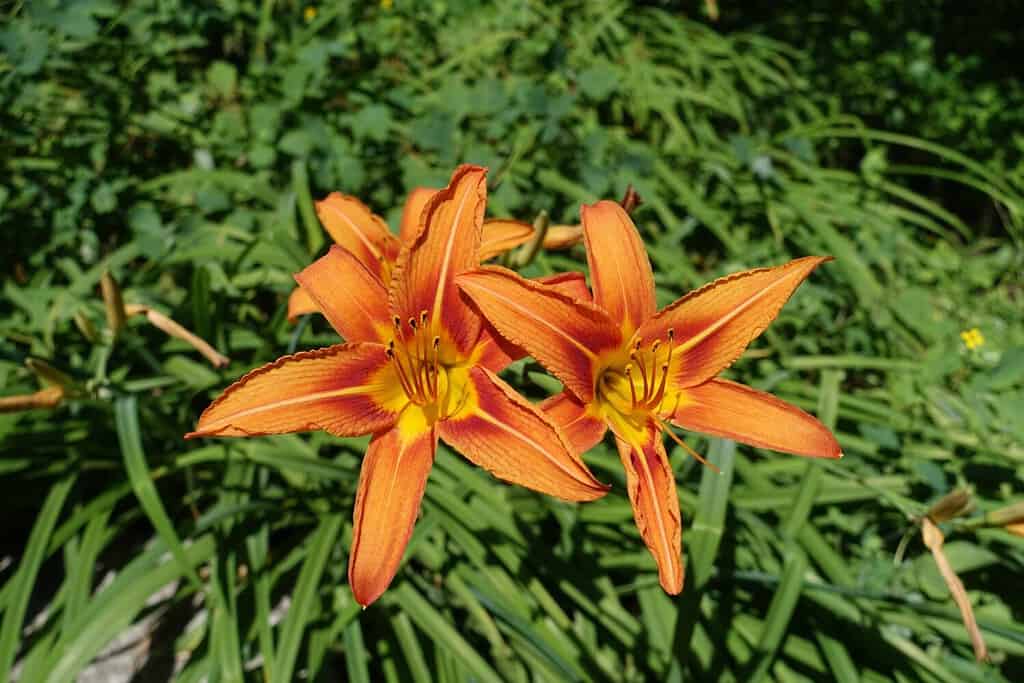
These beautiful flowers are easy to care for and make a great addition to a garden.
©APugach/Shutterstock.com
Daylilies, named after their day-long blooms, feature clusters of bell- or funnel-shaped flowers perched on long stems. Their color palette spans from yellow to red. These plants also have slender, sword-like foliage gathered at the base, accompanied by fleshy roots.
For optimal growth, plant daylilies in late spring or early autumn and water them consistently during the initial weeks. Their peak flowering period is in June, with an array of multicolored blossoms on stems varying from one to five feet tall. While individual flowers live for a day, new blooms usually open successively over a four to five-week span.
For the most vibrant flowers, plant daylilies in a spot with full sun (about 6 hours per day) and ensure the soil is moist but well-drained. Be aware that while daylilies are not toxic to humans or dogs, they can be harmful to cats.
Daylilies are renowned for being effortless to cultivate, requiring minimal upkeep. They’re sturdy perennials that can survive for many years, even with occasional neglect. Their resilient nature and drought tolerance make daylilies an excellent selection for seniors seeking low-maintenance gardening options.
3. Lavender (Lavandula)
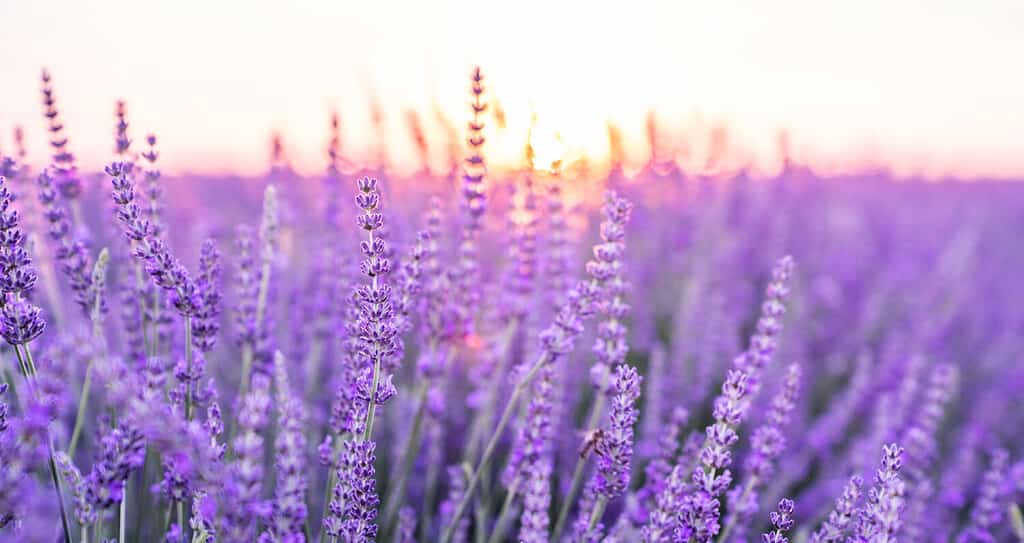
Lavender is a very senior-friendly garden plant.
©ESstock/Shutterstock.com
Another great garden plant that is senior-friendly is lavender. Lavender refers to a group of perennial, herbaceous shrubs from the Lavandula genus. This plant is commonly grown for its ornamental appeal and wonderful aroma. These compact plants have branching, spreading growth with gray-green leaves and elongated stems that bear flowers. The blooms are blue-violet, arranged in a spiral pattern of 6 to 10.
Spring’s warm soil makes the onset of April the ideal time to plant lavender. Although lavender is usually associated with summer blooms, some varieties flower early in the spring. Meanwhile, others are late bloomers, showcasing their beautiful blooms from mid to late summer.
Lavender is relatively low-maintenance once it’s established, but it does require annual pruning. Unpruned plants may become woody and spread out, resulting in an empty center. For best results, lavender needs a sunny spot and well-draining soil; the more sunlight it receives, the more potent the scent from its leaves and flowers.
A bit of afternoon shade could be beneficial in regions with intense summer heat.
In addition to its aesthetic and aromatic appeal, lavender is a favorite among seniors for its therapeutic properties. Research suggests this lovely purple plant is more than just a fragrant ornament; it may also help alleviate symptoms of various health conditions.
4. Coneflower (Echinacea)
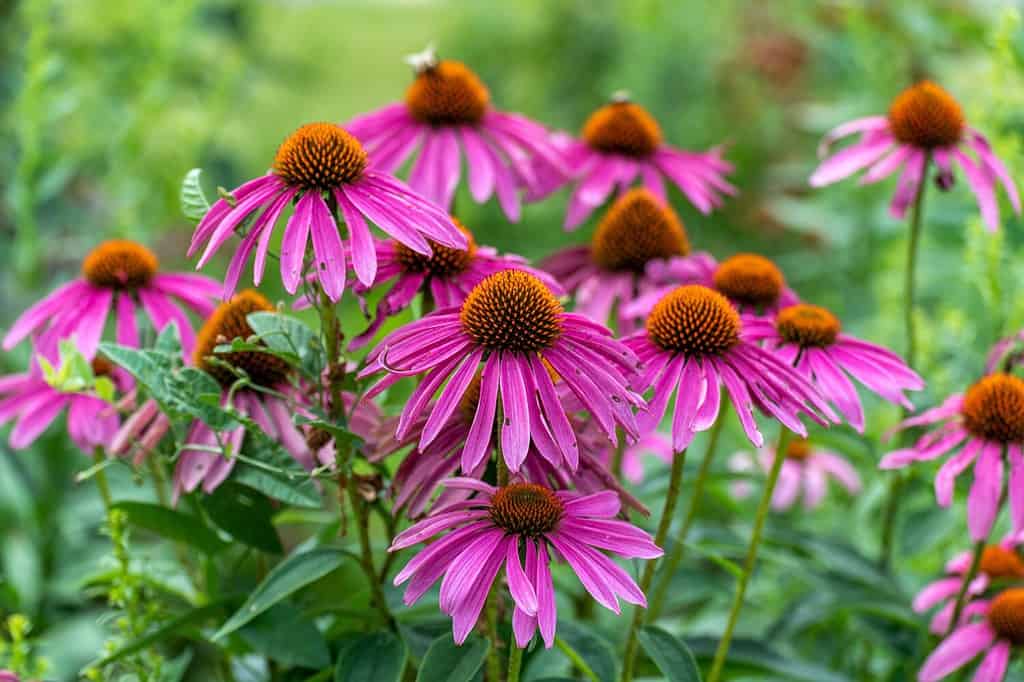
These purple flowers add a lot of color to gardens in the summer and fall.
©Barbara Smits/Shutterstock.com
The coneflower is a perennial herb from the Asteraceae (daisy) family, native to the United States. This plant typically grows to a height of 3 to 4 feet and blooms pinkish-purple flowers from early summer through mid-fall. You can also find some varieties in white, yellow, and pale peach to orange, pink, and red.
Spring is the ideal time to plant coneflowers once the threat of frost is gone. Early fall is also suitable for planting, provided that the new plants have a minimum of 6 weeks to establish their roots before the first frost. If not, they might not return in the following spring.
Plant them in an area that gets full sun and has efficient drainage. A good length of time for root development before the first winter is highly beneficial.
Caring for these plants is straightforward, which makes them an excellent choice for senior gardeners. Basic requirements include regular watering (around an inch per week), adding a thin layer of compost in the spring, and optionally cutting back in the fall.
Although the purple coneflower is a robust plant that can tolerate less-than-perfect growing conditions, some routine care is still needed for it to bloom beautifully year after year.
5. Plantain Lilies (Hosta)
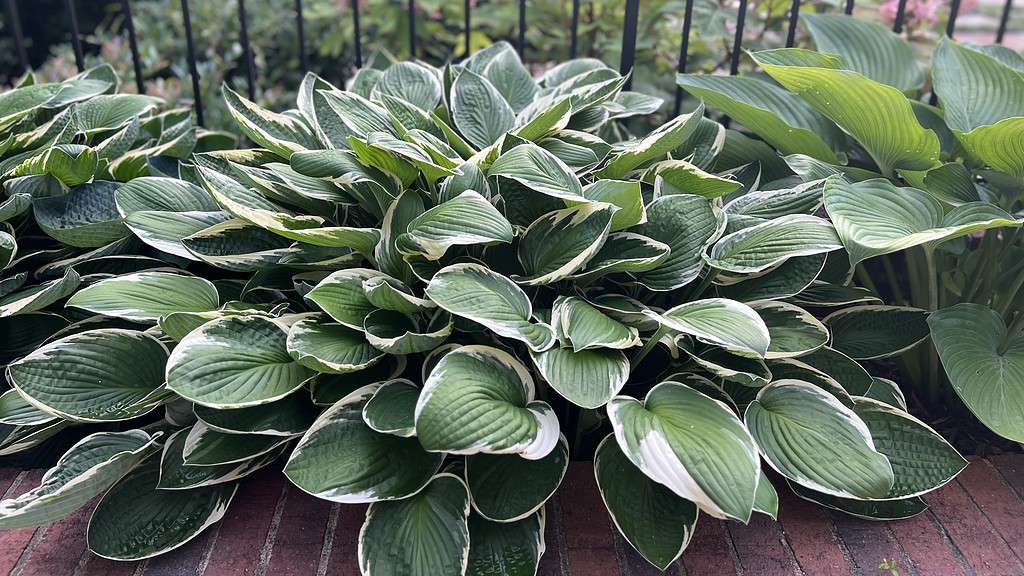
The plantain lily, also known as a hosta, is a small perennial that grows into a dense, round cluster. Its distinctive, thick, slightly curved leaves are dark green with a bluish hue, featuring broad, irregular yellowish edges that gradually turn creamy-white.
For optimal growth, plant hostas in spring or fall. They can also be grown indoors with the right conditions, but they require a cold dormant period annually to truly thrive. Hostas exhibit a wide growth range, from as small as three inches to as tall as three feet.
The plant’s appealing leaves are crowned in early to mid-summer with tall, funnel-like flowers, presenting in hues of white, lavender, or purple. Some varieties even offer a pleasant fragrance.
Plantain lilies prefer conditions ranging from partial to full shade, and they grow best in fertile, moist, and well-drained soils. Some varieties can even tolerate sunlight, given sufficient moisture.
For a versatile, easy-to-care-for perennial, the plantain lily is an excellent choice, particularly for seniors and novice gardeners. Once established, these plants also exhibit drought tolerance.
6. Zinnia (Zinnia spp.)

If you want an easy-to-care-for annual garden plant, consider
Zinniaplants.
©Sutta kokfai/Shutterstock.com
Zinnia, another member of the daisy family, or Asteraceae, is a bushy plant or a small shrub. The leaves’ shape varies depending on the species, ranging from pointed like arrows, spear-shaped, to narrow, and can be either rough or soft. As annuals, zinnias grow, bloom, and produce seeds for one season but do not return the following year.
Plant zinnias in the late spring when the danger of frost has passed, and the soil has warmed. You can start with seeds indoors, use store-bought plants, or sow directly into the warm soil. These easy-to-grow wildflowers bloom from mid-summer until the first frost, bringing vibrant, joyful colors to any sunny area.
Zinnias thrive best in full sun for at least 8 hours a day and prefer warm locations. The soil should be well-drained, and heavy soils can be improved by adding compost or sand.
Aside from their beauty, zinnias provide various benefits, such as attracting pollinators, serving as lovely cut flowers, and even reducing stress. Maintaining these plants is quite easy; their quick growth helps to suppress weeds, they require little fertilization (just an occasional balanced mix), and they don’t need mulching. Zinnias are perfect garden plants for seniors, as they are generally effortless to grow!
7. American Boxwood (Buxus sempervirens)

Boxwood shrubs are a great addition to yards and gardens.
©ThomBal/Shutterstock.com
The American boxwood is similar to its English counterpart but has a broader tolerance for colder climates. This plant, perfect for pots, requires minimal upkeep and forms a dense shrub due to its blunt-tipped leaves. If allowed to grow untrimmed, the American boxwood can become quite large.
This rounded evergreen boasts glossy, elongated leaves. Come spring, its dark green foliage serves as a backdrop for delicate light green flowers, creating a charming contrast.
The ideal time to plant boxwoods is during the late fall or early spring when temperatures are moderate. Boxwoods thrive in USDA hardiness zones 5 to 8, but numerous hybrids can withstand chillier climates.
Although boxwoods can handle full sun to partial shade, they flourish best with five or six hours of full sun daily. In hotter regions, they should be planted in spots that offer some afternoon shade. If your location experiences dry winter winds, it’s best to select a sheltered site. Boxwoods need well-drained soil, but they can cope with different soil types, though sandy loam is ideal.
The boxwood plant makes an excellent choice for seniors, as it’s quite low maintenance. Their slow and dense growth means their pruning requirements are not demanding, making them easy to manage.
8. Snake Plants (Dracaena trifasciata)

Snake plants are popular house plants, but they can also be added to a garden if you live in a warmer climate.
©Olena758/Shutterstock.com
The snake plant, a stemless perennial, can last for several years with appropriate care. The plant features erect, succulent, sharply-pointed leaves that are deep green with light gray-green stripes running across.
Spring is the ideal season to plant snake plants. If the temperature dips below 55 degrees, it’s best to keep the snake plant inside. You can place the plant outside during the warmer months of spring and summer, but always be mindful of the temperature, as snake plants can’t withstand cold winters.
Watering should be done carefully, ensuring the water fully drains away to prevent root rot. These robust plants can flourish in various light conditions, from low to high. They typically grow faster in brighter light.
One reason snake plants are a popular choice among seniors is their low-maintenance nature. They are resilient, hardy plants that can thrive in relatively dry environments, both indoors and out. They don’t demand much care and can endure long periods of neglect. Not particular about their location and requiring infrequent watering, snake plants are nearly indestructible, making them an excellent choice for seniors.
9. Lettuce (Lactuca sativa)
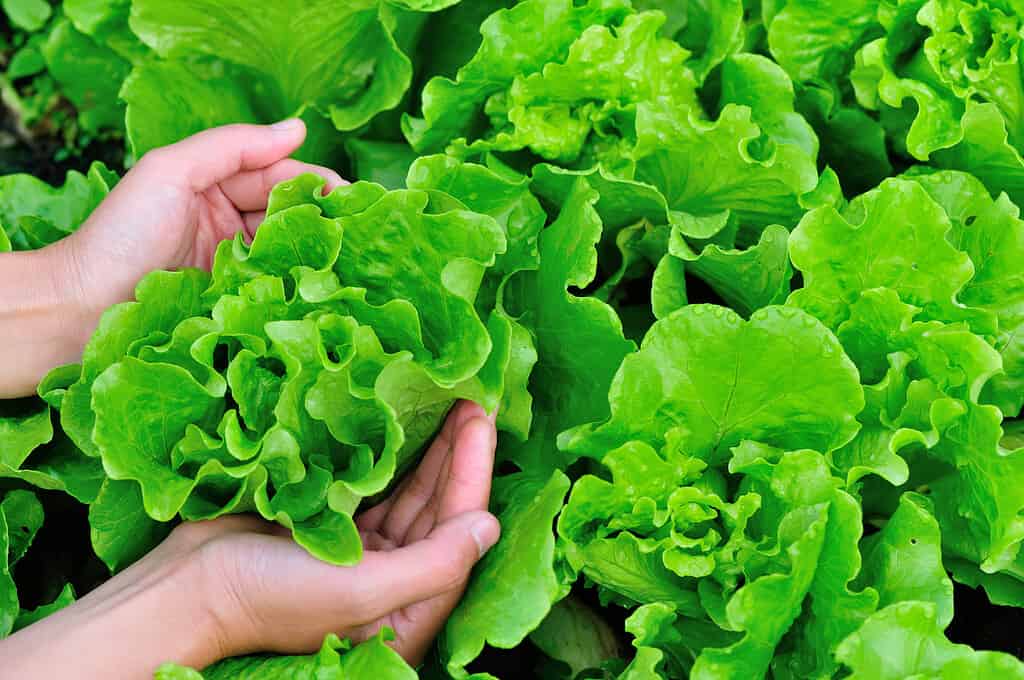
Lettuce is one of the easiest vegetables to grow.
©lzf/Shutterstock.com
Among vegetables, lettuce is notably senior-friendly. This annual plant is primarily cultivated for its leaves, but sometimes its stem and seeds are also used. Primarily found in salads, lettuce also adds a crunchy texture to soups, sandwiches, and wraps.
The ideal times to plant lettuce are during the cooler periods of early spring and fall. This nutritious leafy green can be grown in ground-level gardens, raised beds, or even containers. Lettuce typically blossoms as the weather warms towards late spring or early summer, preferring the chillier seasons for leaf growth.
For optimum growth, lettuce prefers loose, cool soil with excellent drainage. Adding organic matter, such as compost or manure, enhances the soil’s drainage capabilities, supplies necessary nutrients, and optimizes the conditions for growing lettuce. While most varieties of lettuce prefer full sun, make sure to plant your lettuce where it will receive 6 to 8 hours of direct sunlight daily.
Lettuce is truly a senior gardener’s delight! It’s a fast-growing, high-yield plant requiring minimal care. All lettuce types are simple to cultivate, though the loose-leaf varieties that don’t form a tight heart are arguably the easiest.
10. Cherry Tomato (Solanum lycopersicum var. cerasiforme)

Growing tomatoes is a gratifying experience for a gardener.
©Graham Corney/Shutterstock.com
Cherry tomatoes, a variety of small, round tomatoes, are believed to have resulted from the genetic crossbreeding between wild currant-type tomatoes and conventional garden tomatoes. Their size can vary from that of a thumb tip to a golf ball, and they can be either spherical or slightly elongated.
Spring, after the final frost has passed, is the ideal time to plant cherry tomatoes. For an early start, you can sow the seeds indoors about a month before the last expected frost in your region. Once the seedlings reach a height of 6 inches, you can transplant them outside.
Due to their small size, typically 1-2 inches in diameter, these bountiful plants can start yielding fruit in just 55 to 65 days, with some variants ready for harvest in as short as 45 days.
Tomatoes thrive in warmth, so select a spot that receives a minimum of six to eight hours of sunlight daily. The soil should be slightly acidic, loose, and well-draining. While loam and sandy loam soils are ideal for tomato growth, these plants can adapt to all soil types except heavy clay.
What makes them senior-friendly is their easy-to-grow nature. A single plant can provide a consistent crop of bite-sized fruits throughout the season. They’re small, delicious, and notably effortless to grow, encouraging everyone, especially seniors, to explore their gardening skills.
Summary of Best Garden Plants That Are Senior-Friendly
| Plant | Growth Rate |
|---|---|
| Marigold | Fast |
| Daylily | Fast |
| Lavender | Slow |
| Coneflower | Fast |
| Plantain Lilies | Slow |
| Zinnia | Fast |
| American Boxwood | Slow |
| Snake Plants | Slow |
| Lettuce | Fast |
| Cherry Tomato | Fast |
Thank you for reading! Have some feedback for us? Contact the AZ Animals editorial team.








